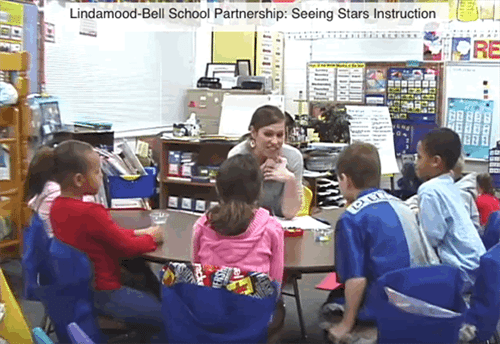|
For some kids, learning to read comes naturally. For others, it’s a challenge. Helping kids with reading struggles can be like solving a puzzle. All of the pieces have to be in the right place for the big picture to come together. It can be hard to know which pieces each individual student may be missing. And even if we know what’s missing, we may not know how to teach the specific skills our students need. So we asked the experts at Lindamood-Bell to tackle six tough questions about teaching reading. Q: “I have two second grade students who struggle to read basic words. They are able to read at Guided Reading Level B, but when we work spelling, they have a difficult time saying individual phonemes and then writing them. What are some activities they can do to strengthen their word recognition?” —Faye M. A: The challenges you describe can be helped by developing the skills that underlie reading and spelling. Students with weak symbol imagery—the ability to visualize letters—have difficulty with remembering sight words and spelling words. They can’t remember the visual patterns of words, so even when they sound out a word correctly, they don’t recognize that same word in the very next paragraph. We recommend addressing spelling right along with reading as you tackle the underlying issue of weak symbol imagery. We like to start with what we call “air writing.” The teacher might say a word, like “top,” and have the student write those letters in the air (spelling). Or the teacher might show a student a card with the word on it and have them write the letters in the air, and then read it from their visual memory. Q: “I have a third grader who mistakes ‘said’ for ‘says’ and ‘they’ for ‘them.’ He mixes up other small words every time he reads. He also sounds out almost every single word as he reads it, which impedes his fluency. He reads at a first grade level. How can I help him improve?” —Danielle K. A: It sounds like this student is attacking every word with sound-by-sound phonetic processing and guessing at the rest. As you know, this is not the type of reading ability he needs for tackling schoolwork. Kids who have difficulty learning sight words often struggle with visualizing letters in words. This is part of the struggle we mentioned above with weak symbol imagery. Many students—even those who have well-developed phonemic awareness—have trouble processing sounds in words and are slow to self-correct their reading errors. Teachers can teach students how to see letters and words and help develop symbol imagery. This skill can be applied to reading and helps with word recognition for the sight words that are challenging for your student. Check out a quick video of a teacher using these strategies from our Seeing Stars curriculum with a small group.
Q: “How can I help my students remember high-frequency words and phonics patterns? We sing the words, I point them out, I’ve tried everything I can think of, but nothing seems to help. Any suggestions would be great!” —Lydia P. A: As you describe, practice alone does not always help students struggling with word recognition and spelling of high-frequency words. Instruction has to get at the root of the problem. Students need to be able to perceive letters and words and need to be able to visualize words. So when you practice common sight words, try to find out whether your students can picture the letters in their heads. Begin teaching them how this might happen. For example, show your students a word like “though,” written on a 3-by-5-inch card. Put it away and have your students read the word from the picture they created in their memory. You can also ask your students questions about the word to encourage visualizing. For example, you might ask, “What letter do you see last?” Q: “I have a second grader who can read all the words on a page of Junie B. or Magic Tree House and then have no idea what it says! She ends up guessing at meaning. How can I improve comprehension?” —Mary R. A: In order to comprehend what they read, students must have strong decoding skills and adequate oral vocabulary. In other words, a child must be able to accurately decode every word on the page and know what all of the words mean. Unfortunately, many students are like the second grader you describe: They can decode well and understand individual words but still have weak comprehension. Students like this often have difficulty understanding the whole picture when they read a story. We like to say that students have difficulty constructing an “imaged gestalt.” This stems from weak concept imagery. This weakness causes individuals to get only “parts” of information they read or hear but not the whole. The good news is that kids can become better at building concept imagery. One of our cornerstone activities from our Visualizing and Verbalizing curriculum prompts the reader to describe the images they “see” in a paragraph, one sentence at a time. As the teacher, you ask questions that help the student refine their image. This interaction develops the language-imagery connection needed to comprehend Junie B. Jones and every other book she encounters! Q: “What do you do with a kindergarten student who doesn’t know the letters in isolation? I could write an M and she has to go through the alphabet song to name it. Even with this, she can’t always tell me the letter.” —Linda L. A: As you know, the letter name is associated with the letter itself—what the letter looks like on the page. To make this connection for your student, you can develop her ability to see letters in her mind’s eye. This is another example where teaching symbol imagery (like we mentioned above) could be helpful. It is the missing link for many struggling readers. Because you’re teaching kindergarten, you have a great opportunity to address it early on! The Seeing Stars program addresses letter acquisition with the “See, Say and Image” task. The teacher shows a letter card for a few seconds, then takes it away; the student visualizes the letter, writing it up in the air with her finger. Then the student gives the teacher the name and sound that corresponds with that letter. Q: “Help! My students can identify bigger words, but sight words are a struggle. I have a group of second grade students who read at a beginning first grade level or lower. They have no problem with bigger words, but smaller words, like sight words, always trip them up. I have tried many different approaches with them, but nothing seems to help. Any suggestions for teaching sight words and basic reading skills?” —Candace M. A: Your challenge is a very common one: students who have learned phonics and can sound out words but have difficulty remembering sight words. These students often do not recognize a word they just sounded out when they encounter it in the next paragraph! Reading is more than phonetic processing. Successful readers can quickly decode a new word and can remember the visual pattern for sight words. Again, we’ve found that the missing piece for many students in the scenario you describe is symbol imagery—the ability to see letters in the mind’s eye. We recommend “capturing” sight words that you need to work on with your group. The practice activity with 3-by-5 cards that we mentioned above can also be helpful here. After putting each word on a note card, practice the words until they can be read automatically. Remember to ask questions about the word to encourage visualizing, such as, “What is the first letter you see?” Our experience in working with struggling readers has shown us that this process of visualization is essential in developing those early decoding skills. This is the second blog in the Helping Kids Who Struggle With Reading and Math blog series, sponsored by Lindamood-Bell. Looking for more strategies for your struggling readers? Lindamood-Bell offers both workshops and curriculum resources to help you reach all of your students. Find out more here.
|




